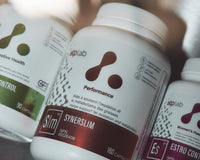Estrogen Dominance Part 1: How you get it, understand it and control it

Part one: Stressing out fertility
Estrogen! The female hormone, isn’t it? Actually no, it's rather strange to call estrogen that way. Sure, it is heavily involved in the women's menstrual cycle and is more prevalent in women than in men (at least for now...), but estrogens are also an important part of the hormone balance in men, and estrogen should by all means not be considered as stand-alone hormone. Its interactions with progesterone alone are immense [1]. Both of them for example, in addition to other hormones and signaling molecules, interact in a coordinated interplay with ovulation and changes in the uterus - even without fertilization. Disturbing this balance is known to heavily affect women in different ways, leading to infertility, mood fluctuations, weight gain and other symptoms related to various kinds of diseases [2,3,4,5]. The same goes for men. While they don’t have to suffer as much as women, high estrogen is linked to different symptoms like infertility, erectile dysfunction, obesity and gynecomastia [6]. Even though there is a lot of (seemingly contradicting) information about it, estrogen dominance still seems to be way too underrated, even in groups with high interest in health. Be reassured though. There is more to estrogen, than just some regulation of the menstrual cycle. Let’s get an overview in this short article about estrogen, its dominance and some relations to things like stress.
Figure 1: Menstrual Cycle and hormones (http://www.healthcmi.com/Acupuncture-Continuing-Education-News/1707-acupuncture-decreases-insomnia-due-to-menopause-increases-estrogen)
Studies on estrogen have come a long way since it was first isolated in the 1930s. Early on, it was discovered that there were many chemicals that had a similar effect on humans like estrogens. Already during the middle of the 20th century, the negative/toxic effects of estrogen became increasingly known [7]. While studies had been published, showing that estrogen may induce infertility, kidney swelling, liver disease, cancer, abnormal blood clotting and seems to work as an endocrine disruptor in animals and humans – fertility and cardiovascular properties have also been shown to improve [2,3,4,5,7,8]. Often dose, timing, laboratory animals, environment and other factors - presumably many of them not even fully understood - all played a role. While high levels of estrogen appeared to be toxic, the data for other dosages was actually very different. It became clear that estrogen, progesterone, and all other hormones and signaling agents interacted with each other in a tightly regulated system. However, this process was by no means totally internal and unaffected by the environment and other factors. Several parts of the brain take part in the regulation of estrogen and especially in women, levels do increase and decrease in a well-coordinated rhythm most women know very well. At least as long as it doesn’t get disturbed by certain exogenous substances or environmental factors, which we’ll get to in a bit. Through the hypothalamus and pituitary gland, several signaling agents increase estrogen, to start the ovulatory phase which later on causes progesterone to increase to ”counterbalance” the higher estrogen levels – while having its own functions during the luteal phase. As all payers feedback themselves back to baseline, a new cycle can start, which provides a new egg for fertilisation. At least under normal circumstances and of course strongly simplified. Women are way more complicated [9]. The secretion of something called luteinizing hormone alone has a massive amount of different interactions on several steroid hormones, including testosterone, when it is released during period. That alone should give a hint about how risky it might be to inject a hormonal substitute, especially long-term. It also gives some insight on how important estrogen actually is, as it affects a huge plethora of other hormones, neurotransmitters and organ functions [9].

Figure 2: Effect of LH on Thecal cells (https://www.ncbi.nlm.nih.gov/books/NBK279054/)
Estrogen and the entire female cycle are an indescribably intriguing process of communicating with the environment and inner stability (you could say that this is a typical statement of a male author who doesn’t have to go through it). Stress and estrogen dominance were linked early. Some studies with mice showed how stress and estrogen affect each other in a vicious cycle [10]. In mice, estrogen caused the pituitary gland to continue to release ACTH (adrenocorticotropic hormone), although cortisol levels were elevated. Normally ACTH secretion gets inhibited by higher levels of cortisol (negative feedback loop). Increased cortisol levels continued to increase aromatase activity (necessary for the production of estrogen), which continued to increase estrogen. Not to mention that it seemed to have a negative impact on the learning ability on rodents. Not surprising. Who would be able to incorporated new memories, when they are stressed the heck out?A vicious circle, fueled by fear, plastic bottles and other xenoestrogen containing things, unrest and cultural as well as social developments. Estrogen alone would not be able to do this. Cortisol neither. A lack of protective mechanisms and too much of cortisol and estrogen however, can in the long run have enormous effects. Not just on our behaviour and the likelihood of having children. Transferred to our current way of living in modern industrialized countries, where we tend to overburden our bodies with a lack of sleep, social isolation (Facebook is no social interaction), heavy workouts, lack of regeneration, time pressure, unfulfilling lifestyles, drugs, bad lighting, overstimulation, bad eating habits, overstressing on food, dogmatism and so much more – there is lots we can do. One thing is interesting though [11]:
As discussed, there is some evidence that the HPA activity is associated with depression, at least in males. Interestingly, we have found that adrenal glucocorticoids are necessary for the enhancing effect of stress on conditioning at times (Figure 5A), yet they do not contribute significantly to the impairment in females (Wood et al., 2000) (Figure 5B). , That adrenal steroids do not contribute is more or less under stress and unstressed conditions (Shors et al., 1999). None-theless, these results suggest that the sexually dimorphic effects of stress on conditioning are mediated by differing hormonal-substrate-by-adrenal hormones in males and ovarian hormones in females. Minimally, the data illustrate why we can not assume the female expression of a disorder is simply the same as a male with the addition of ovarian hormones. [Study]
Such findings show how different men and women sometimes are. There definitely is a strong link between estrogen and stress, going both ways. One thing at least is pretty clear: Hormones are powerful and definitely play an important role for us. At the same time, they are often far more complex than we imagine. {In this article}, we’ll get down to business on how to protect oneself from too much estrogen.
References: 1 https://www.ncbi.nlm.nih.gov/pubmed/3290579 2 https://www.ncbi.nlm.nih.gov/pmc/articles/PMC5351695/ 3 https://www.ncbi.nlm.nih.gov/pmc/articles/PMC2689796/ 4 https://www.ncbi.nlm.nih.gov/pmc/articles/PMC3753111/ 5 https://www.ncbi.nlm.nih.gov/pmc/articles/PMC2440795/ 6 https://www.ncbi.nlm.nih.gov/pmc/articles/PMC2770912/ 7 https://www.ncbi.nlm.nih.gov/pubmed/3814500 8 https://www.ncbi.nlm.nih.gov/pmc/articles/PMC3945907/ 9 https://www.ncbi.nlm.nih.gov/pmc/articles/PMC3640235/ 10 https://www.ncbi.nlm.nih.gov/pubmed/10938577 11 https://www.ncbi.nlm.nih.gov/pmc/articles/PMC3374589/





